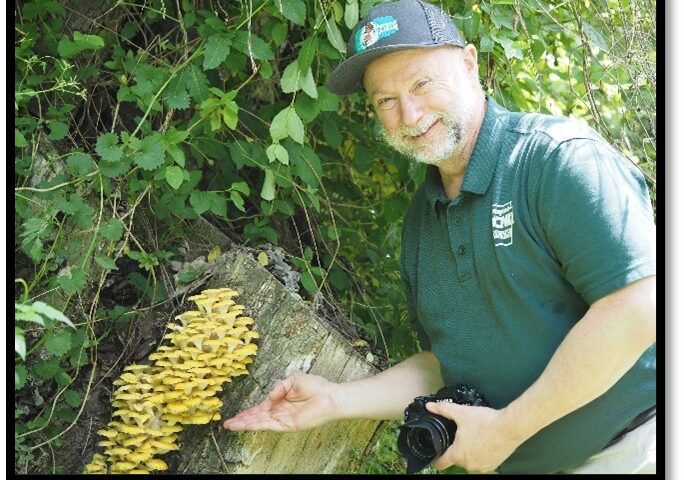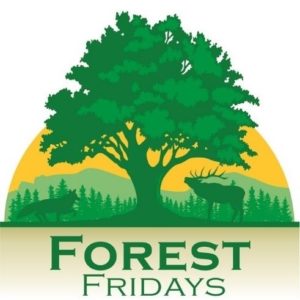
by John Schwartzer
Upon close inspection, you might be surprised to see large, strange swellings deforming parts of a plant, tree, or shrub. These odd lumps are called galls and can occur on thousands of plant species. Galls are abnormal plant growths that are caused by a variety of factors. Insects are the most common cause of gall formation, which occurs from growth regulator disruption through feeding, egg deposition, or larval development within the plant. Worldwide, there are 133,000 gall-making insects3, 2000 of which are found in the US1. Many galls are created by tiny wasps, which can have very complex life cycles with sexual and asexual generations making differently shaped galls.1 Aphids, thrips, midges, moths, gnats, and the tongue tying Phylloxerans and Psyllids are all common gall forming insects. Galls can also form from the feeding of nematodes and bacterial and fungal infections.1 Galls can become home to other critters after the original organism moves out. These second occupants are known as “inquilines.”
While most galls are only known by their scientific name, the common names often describe the gall or its location. Interesting examples include bullet galls, hackberry nipple galls, pocket galls, blister galls, finger galls, acorn plums, oak-apples, tongues of fire, robin’s pincushion, and roly-poly galls. Just about every part of a plant is susceptible to a gall, as evidenced by names like leaf, fruit, stem, twig, flower, and root galls. Multiple locations can be affected on the same plant by different species. Eight-hundred types of galls occur on oaks10, and 80 percent of galls reported in the US occur on oaks.1
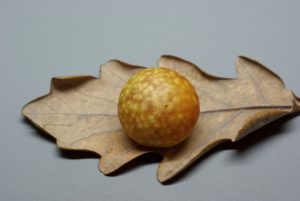
Oak-apple gall. Photo by B. Werner, commons.wikimedia.org
A frequently spotted and sometimes very large leaf gall on oaks is the oak-apple gall. It is created by the fittingly named oak apple wasp. When opened, they look similar to a dried gourd with stringy structures holding a central larval cell.
A form of writing ink known as iron gall ink was used from the time of the Romans until the 20th century and was made from iron and tannins almost exclusively extracted from oak galls.4 The ink degrades over time releasing chemicals that cause major problems for writing collectors and curators.9
In England, they call the galls that form on juniper twigs “tongues of fire.” Pennsylvanians can often spot the similar cedar apple rust on eastern redcedars. These perennial woody lumps take on a disturbing appearance after a soaking rain when spore bodies extend out to infect their alternate hosts: apples, hawthorns, and quince.
In a pinch for fishing bait in the late fall through winter? Crack open the golf ball-sized gall on a tall goldenrod for free bait. The larva of the goldenrod gall fly makes a passable substitute for a “spike” (a small worm) when running short. Woodpeckers also find them a tasty treat, a good reason to leave them alone in the wildflower garden. These larvae produce natural antifreeze to keep from freezing in winter.5
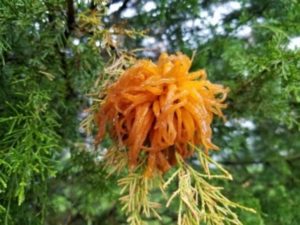
Cedar apple rust, Photo by: C. Manneri, University of Delaware
Galls are rarely a problem for the plant and mostly an aesthetic nuisance, but some are serious pests. American Phylloxera infestations on grape roots almost ruined the European wine industry. Black knot galls can damage cherry trees, which can break at the gall site. Stressed plants are sometimes more affected, so reducing stressors from drought or compaction can help reduce gall formation. There are natural predators and parasites that feed on gall forming insects making insecticides a poor choice. Some specimens of a tree will be heavily infested while neighboring trees will be largely untouched due to varying resistance. The only way to eliminate galls is to select species to plant that are not susceptible.
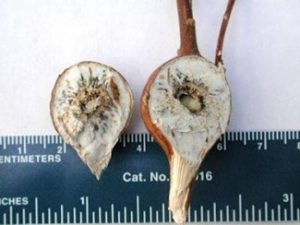
Goldenrod gall. Photo by J. Mccormac. www.jimmccormac.blogspot.com
Sources:
- What causes galls on trees? Are galls harmful to trees? (tamu.edu)
- gall-making-insects-and-mites.pdf (tamu.edu)
- Espírito-Santo M.M., Fernandes G.W. How many species of gall-inducing insects are there on Earth, and where are they? Entomol. Soc. Am. 2007;100:95–99. [Google Scholar]
- Irongallink.org
- Goldenrod Gall Fly, Eurosta solidagnis – Wisconsin Horticulture
- Ohio Birds and Biodiversity: Goldenrod Gall Fly (jimmccormac.blogspot.com)
- Cedar Apple Rust | Plant Diagnostic Health Topics (udel.edu)
- File:Oak apple BW 2014-11-16 20-35-06.jpg – Wikimedia Commons
- The Ins & Outs of Iron Gall Ink (amphilsoc.org)
- Interesting Oak Leaf Insect Galls | BYGL (osu.edu)



